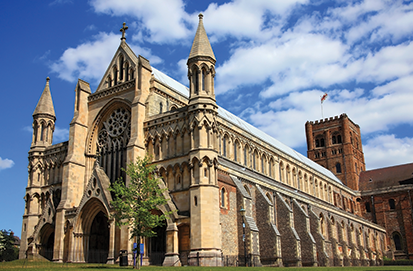The Economic and Social Impacts of England’s Cathedrals
The Economic and Social Impacts of England’s Cathedrals
Ecorys was commissioned by the Association of English Cathedrals to conduct a study on the economic and social impacts of cathedrals.
Economic impacts are estimated using the flows of expenditure associated with the day-to-day operation of cathedrals and the local spending of cathedral visitors. The assessment of social impacts is based on evidence related to worship, volunteering, learning and community engagement. Evidence was collected using a survey of all 42 English cathedrals and a series of six case studies. Figures given are for 2019. The early impact of COVID-19 in 2020 was also explored and is intended to give an insight into the key trends observed in 2020, rather than to provide a complete analysis of the impact of COVID-19 on cathedrals.
The study found clear evidence that cathedrals make a significant contribution to their local economies.
Economic impacts were generated directly as a result of the employment of staff and the procurement of goods and services; both procurement in support of everyday operations and of that related to major restoration or capital development projects. Significant impacts were also generated as a result of the local spending of cathedral visitors – this additional visitor-related impact alone was estimated to be in the order of £128 million during 2019. Further impact was generated by the multiplier effects of this visitor-related spend. In total, cathedrals were estimated to generate total net additional local spending of around £235 million per year.
There is also evidence that the activity of cathedrals resulted in a range of social benefits which would be expected to impact positively on the wellbeing of participants and of society. In addition to a programme of regular and special services, cathedrals provided a wide range of pastoral care and outreach activity in 2019, as part of their role in supporting the local community. Cathedrals were also used for numerous events, concerts, ceremonies and other activities. As heritage sites and through the activities they offered, Cathedrals also provided numerous opportunities for both formal and informal learning. It was estimated that over 308,000 learners participated in organised educational activities in 2019.
The coronavirus brought about a number of challenges for cathedrals, particularly in the form of reduced visitor numbers. Due to government mandated closures and restrictions on gatherings, visitor numbers in 2020 (excluding those attending services and educational events) fell by approximately 70% compared to 2019. Visitors typically provide a significant source of income for cathedrals through entry fees, donations, and on-site spending in catering and retail outlets. As such, this fall in visitor numbers had a significant effect on cathedrals’ income levels in 2020.
Similarly, COVID-19 also resulted in a fall in cathedrals average non-visitor income in 2020, driven by a reduction of almost 80% in income generated from the use of cathedral facilities. This reduced income had a direct impact of cathedrals ability to be self-sustaining in 2020, and cathedrals estimated that their finances will be constrained for some time to come. Emergency grants provided cathedrals with much needed finances during 2020.
COVID-19 also gave rise to new opportunities in encouraging cathedrals to reach people in new ways, including live streaming their services and developing online resources specifically for schools, including tours, talks and activity packs.
The full report can be downloaded here and the accompanying case studies here.
For more information, please contact Research Manager, Marie Williams.

22 July 2021
3 minute read
Sectors
Key Experts
Maire Williams
Research Manager



